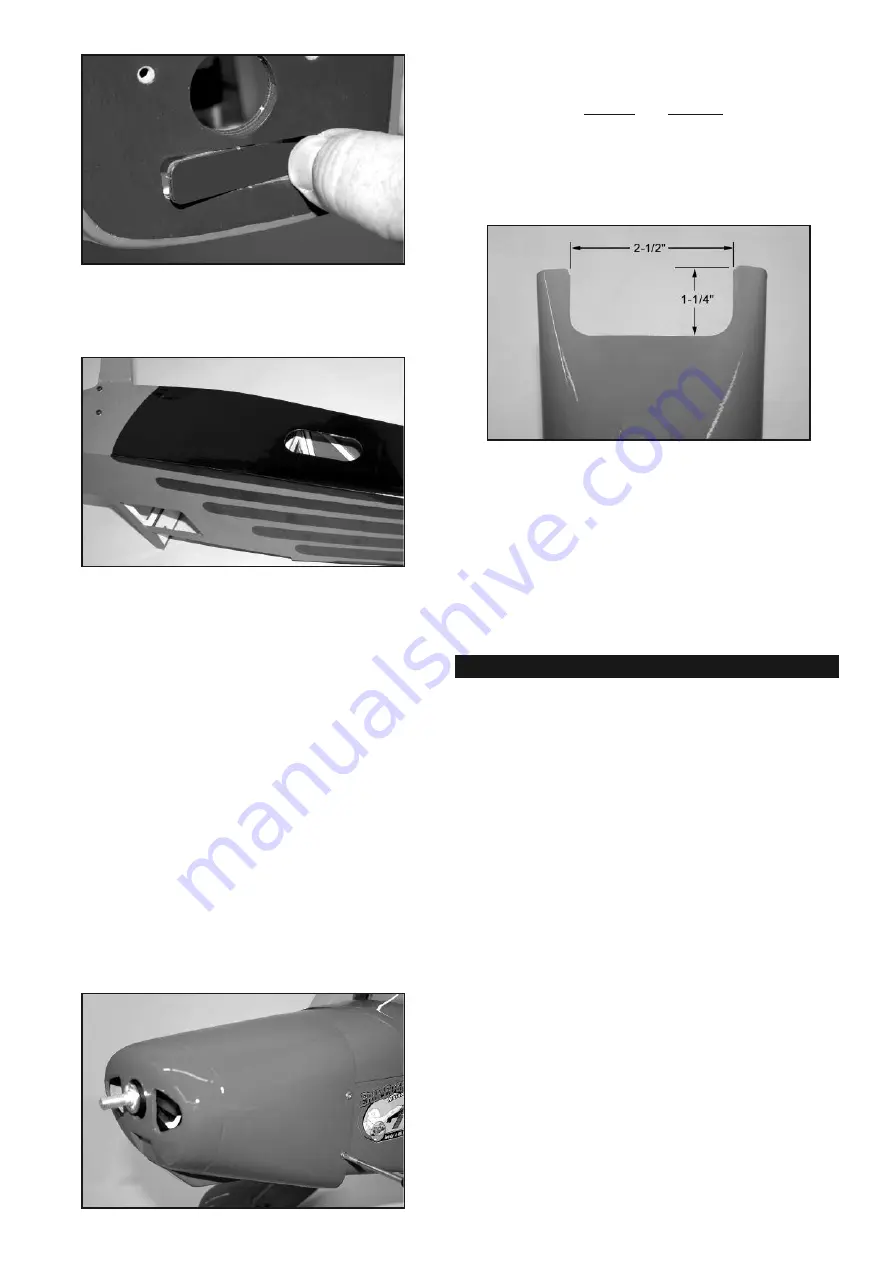
12
❑
34) If after test flying you find that the ESC or battery are getting
warmer than you would like, make an air exit hole in the bottom
of the fuselage, as shown here. This will improve the air flow
through the fuselage.
COWLING INSTALLATION
For this section you will need the fuselage and:
(1) Fiberglass Cowling
(4) M3 x 10mm Screws
❑
35) Mount the cowling on the fuselage with the four M3 x 10mm
Screws provided. Notice that the holes for the four cowl mounting
screws are already pre-drilled in the cowling - two on each side.
a) First test fit the cowling on the fuselage. As you pass it over
the motor, make sure all the wires are out of the way. Carefully
adjust the exact position of the cowling. Make sure you have ad-
equate clearance between the front of the cowl and the back of
the propeller, and that the prop shaft is centered in the hole. Use
low tack tape to hold the cowling in place for the next step.
b) Use a 5/64" or #45 bit to drill a pilot hole for the top left cowl
mounting screw. Center the drill in the hole in the cowling and
drill into the fuselage side. Install an M3 x 10mm screw in the pilot
hole - do not over-tighten the screw.
c) Recheck the position of the cowling and make any adjust-
ments needed to get it back in position.
d) Now drill another pilot hole for the upper screw on the other
side of the cowling. Install the screw.
e) Repeat this process to install the two bottom cowl mounting
screws. Remove all the tape.
❑
36) With a fully cowled motor, it is very important to make sure
your power system is getting proper cooling. Air flowing into the
front of the cowling must have a place to exit the cowl. In fact it’s
best to have more air exit area than inlet area to create a positive
air flow through the cowling - an actual suction effect - drawing
the heated air out of the cowling so that more cool air can come
in. This positive air flow keeps your motor running cool. We rec-
ommend that you make a simple opening at the bottom rear edge
of the cowling as shown in the next photo, to provide additional
air exit area. The exact dimensions are not critical.
Note: A Dremel® Tool, or similar rotary hand-tool, with an assort-
ment of bits is without a doubt the best tool to use for making
cutout in the fiberglass cowling. However, if you do not have ac-
cess to such a tool, you can cut the opening with a drill, a hobby
knife, and a sanding block. First first drill a series of almost touch-
ing 1/8” holes inside the pattern lines; then use the knife to cut
through the connecting material between each hole; and finally
finish the edges of the opening with the file or a sanding block.
❑
37) Mount a suitable propeller on your motor.
Skip this section if your using an electric power setup
For this section you will need the Fuselage and:
(2) Nylon Engine Mounts
(4) M4 x 25mm Mounting Bolts
(4) M4 Flat Metal Washers
(1) Fuel Tank
(1) Rubber Stopper Assembly
(1) Fuel Pick-Up Weight (clunk)
(1) Fuel Line Tubing for inside tank
(1) Plywood Fuel Tank Front Mount
(1) Plywood Fuel Tank Rear Mount
(1) Nylon Throttle Pushrod Tube
(1) 17-3/4" long Wire Pushrod with M2 Hex Nut
(1) Metal RC Clevis
(1) small piece of Fuel Tubing
(1) Metal Pushrod Connector with Set Screw and Hex Nuts
(1) Plywood Throttle Servo Mount
(1) Balsa Block
The T-CLIPS is designed for INVERTED glow engine mounting.
We found that to be the most trouble free installation in most
cases. However with some glow engines you may want to explore
the option of side mounting. Note that the pre-mounted blind nuts
for the engine mounts are symmetrically spaced - i.e. the same
spacing left-to-right as up-to-down.
The following instructions show a typical 2-stroke glow engine
being mounted inverted.
❑
38) Bolt the two Nylon Engine Mounts on the front of the fire-
wall, using M4 x 25mm Bolts and M4 Flat Washers provided.
GLOW POWER SYSTEM


































